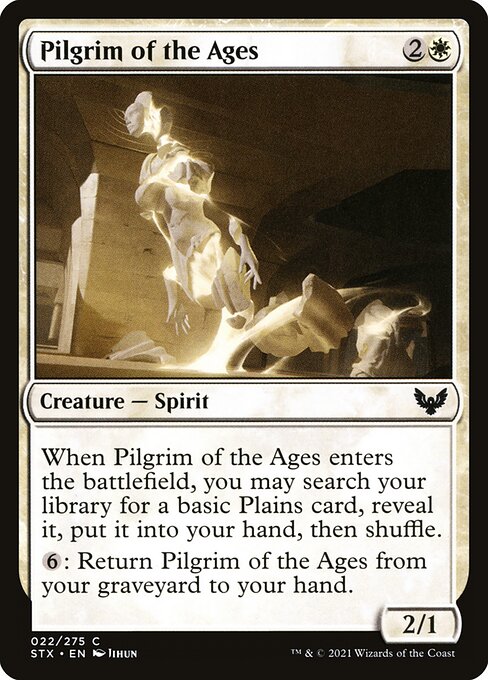
Image courtesy of Scryfall.com
Design DNA and the White Archetype in Strixhaven
Magic: The Gathering’s Strixhaven: School of Mages isn’t just about campus lore and grand spells; it’s a masterclass in design consistency across related archetypes. Pilgrim of the Ages, a white creature from the STX set, embodies that elegance by pairing a straightforward body with two complementary effects that echo white’s long-standing identity: tutoring and resilient value. At first glance, a 2/1 for 3 mana might look modest, but in a color that prizes efficiency and planning, the card’s true strength is the way its abilities weave into a broader strategy. 🧙♂️
When Pilgrim enters the battlefield, you may search your library for a basic Plains card, reveal it, put it into your hand, then shuffle. This is a classic white tempo/value line—early-game acceleration that doesn’t overreach but steadily compounds your options. Plains, as a fundamental land type, anchors white’s color identity, and Pilgrim’s tuned grab for Plains keeps the deck honest to its color commitments. The effect is deliberately constrained (you’re not tutoring any land—only Plains), which reinforces the idea that Strixhaven’s campus is a world where every decision about resource access is thematically grounded in the school’s geography. And yes, the choice of Plains matters: it’s a land that supports white’s aggressive and defensive plays alike, enabling a smooth arc from defense to decisive turns. 💎⚔️
Where the design thread deepens is in the second ability: {6}: Return this card from your graveyard to your hand. That line might feel like a risk-vs-reward trap—spend six mana to fetch Pilgrim back to hand—but it slots neatly into white’s archetypal resilience. In the right board state, Pilgrim can become a reliable value engine: fetch a Plains now, then reassemble your toolkit later by recasting Pilgrim to start the Plains engine anew. It’s a design pattern you’ll recognize across related white archetypes—cards that push for incremental advantage, with recapture options that reward patient play and disciplined planning. This two-stage identity—early Plains tutor, late-game recurrency—illustrates how Strixhaven’s white create-a-campus flavor can stay cohesive while still offering distinct lines of play. 🧭🎲
“White’s strength often lies in the careful choreography of resources—making each action count, then building toward a durable board presence.”
Artist JiHun Lee captures a serene, scholarly vibe in Pilgrim of the Ages, aligning with Strixhaven’s art-forward approach that couples theme with memorable visuals. The card’s aura—a pale, hopeful spirit on the path of knowledge—mirrors the design philosophy of the set: players are invited to invest in learning, then leverage those lessons for long-term value. This is evident in the card’s endurance: a 2/1 frame that’s not asking to smash through foes but to unlock options that persist beyond the moment. The result is a design that feels inevitable in any white-heavy strategy that leans on library manipulation and preservation rather than brute force. 🔥
For deckbuilders, Pilgrim of the Ages is a thoughtful bridge between tempo and inevitability. A common rarity in Strixhaven’s machine-like engine, it doesn’t need to shout to be effective. Its strength lies in its reliability and predictability—the hallmarks of white archetypes that prize disciplined resource management. It’s the kind of card you draft into a plan rather than force into a plan, and that kind of design consistency is what makes Strixhaven’s color wheel feel both fresh and familiar. 🎨
In terms of broader archetypes, Pilgrim’s motif slots alongside other white creatures that reward careful sequencing—early plays that set up later value, with a safety valve in the graveyard that keeps options open. White has long favored this balance of immediate impact and late-game resilience, and Pilgrim of the Ages slides right into that lineage. It’s not just about Plains; it’s about how white can shape a game’s tempo while keeping doors open for retrieval and repeated value. 🧙♂️💎
Practical takeaways for players and builders
- Plan your land-fetch around Plains. Pilgrim rewards you for prioritizing Plains in your deckbuilding, ensuring the ETB search pays off consistently. This cements Plains as a strategic pillar in your white shell. 🎯
- Value the graveyard recursion. The {6} ability isn’t flashy, but it offers a durable backstop. In long games, returning Pilgrim to your hand can double-dip on Plains-fetch moments and keep you advancing your board state. ⚔️
- Respect the body and tempo. A 2/1 for 3 mana is serviceable on offense but can be fragile. Use Pilgrim to pressure early while you set up your plan, then leverage its recursion to sustain pressure or stabilize. 🧙♂️
- Tie-in with Strixhaven’s flavor. The “pilgrim” motif echoes the school’s lore of students venturing through knowledge and magic. The card’s design supports that narrative by marrying an entry-level tutor with a future-forward reuse mechanic. 🔮
- Observe cross-set consistency. Pilgrim’s dual-ability structure mirrors white archetypes across sets that seek sustainable value through repeatable effects, ensuring players feel at home when expanding their white-centered strategies. 💡
If you’re curious how this kind of design ethos translates beyond MTG, you might enjoy exploring content from our network. The featured links below span topics from digital art production to government crypto discussions, all reflecting design philosophy in different media—each a mirror of strategic thought in card design and deck-building. 🧠🎲
Neon Desk Mouse PadMore from our network
- https://crypto-acolytes.xyz/blog/post/exploring-the-potential-of-cbdcs-and-government-crypto/
- https://transparent-paper.shop/blog/post/selling-digital-zines-and-pdf-artbooks-a-simple-guide/
- https://blog.digital-vault.xyz/blog/post/analyzing-traumatic-visions-engagement-across-mtg-archetypes/
- https://crypto-acolytes.xyz/blog/post/streaming-horror-as-performance-art-crafting-fear-for-viewers/
- https://transparent-paper.shop/blog/post/how-ai-tools-create-stunning-digital-paper-patterns/